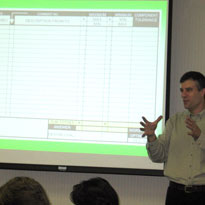DWDM – Introduction
- Course:DWDM – Introduction
- Course ID:DWDM101 Duration:2 days Where: Your Office (7+ Persons)
- Download Course Description (PDF)
Available as a private, customized course for your group at your offices or ours and in some cases as a WebLive(TM) class.
Course Outline
- Introduction to Optical Technologies
- An overview of the transport technologies
- Optical technologies: Their advantages and disadvantages
- The T-Carrier System
- Framing
- Synchronization
- Extended super frame
- Capacity overview
- Review of SONET/SDH
- Framing
- Overhead
- SONET structures
- SONET carrier system
- SONET synchronization
- Concatenation
- BLSR
- WDM Technologies
- History of WDM
- Evolution of DWDM
- Drivers of DWDM
- Drivers of CWDM
- Overview and comparison of DWDM and CWDM
- Overview of a functioning DWDM system
- Signal generation
- Combiners/Mixers
- Transmitters
- Receivers
- How optical fiber works
- Refraction
- Reflection
- Cladding
- Core
- Overview of multimode fiber
- Overview of single-mode fiber
- Step index
- Functional Descriptors: DWDM
- Standards and definitions
- Channel spacing
- Multiplexers
- Optical multiplexers
- Add/drop multiplexers
- Wave division multiplexing
- Signal regeneration
- Functional Descriptors: CWDM
- ITU standard definition
- Channel spacing
- Applicability and use
- Dense WDM
- ITU standard definition
- Channel spacing
- Wavelengths
- EDFA
- DWDM terminal multiplexer
- Add drop multiplexer in DWDM
- DWDM terminal duplexer
- Optical supervisory channel
- DWDM Systems
- Typical laser design: An overview
- ITU Grid G.692
- Transponders
- Re-transmission – 1R
- Re-time and re-transmit – 2R
- Re-time, re-transmit and re-clock – 3R
- Multiplexed transponders
- Transmitters
- Attenuation
- Chromatic dispersion
- Nonlinearities
- Optical amplifiers
- Optical receivers
- OADMs
- Roadm (reconfigurable add/drop multiplexer) technology
- DWDM in single-mode fiber systems
- DWDM in multimode fiber systems
- DWDM Applications
- Long distance
- Long haul
- Self healing rings
- Diversity
- Network expansion
- Course Wrap-up
- Future evolution of optical technologies
- Directions for advanced study
- Course recap, Q/A, and evaluations
Course in a Nutshell
Dense Wavelength Division Multiplexing (DWDM) is a key part of the world’s communications infrastructure. The revolution in optical transmission technologies that has occurred in this decade has allowed operators to dramatically increase their transmission capabilities at a fraction of the costs of legacy technologies. For anyone involved with telecommunication and information technology, understanding this technology is of vital importance.
In this introductory course, you will learn the essentials of the T-carrier system, review the SONET/SDH basics, and study the technology and applications of dense wavelength division multiplexing. Toward the end of the course, we will also touch upon coarse wavelength division multiplexing.
Customize It!
We can customize the course to address the concerns unique to the various audience groups including transmission, network, or systems engineers, chipset manufacturers, R&D specialists, optical system installers, managers and executives, marketing and sales personnel, operations and support personnel, and others. Most customization is performed at little to no added cost.
Learn How To
Describe the key concepts and techniques of transport/optical transmission technologies including:
- T-carrier system
- SONET/SDH
- DWDM
- Coarse WDM
Aimed At
Telecommunications transport, systems, and network engineers, capacity managers, and others responsible for the planning, design, or day-to-day operation and management of large telephony systems.
Prerequisites
While there are no particular prerequisites for this course, some comfort with Physics and Mathematics will be helpful. However, all necessary Mathematics/Physics concepts will be reviewed within the course as needed.

